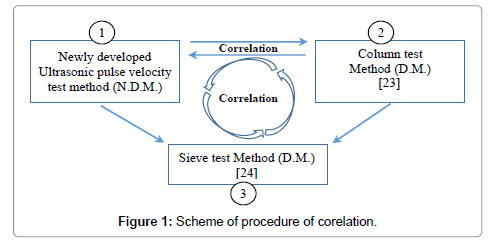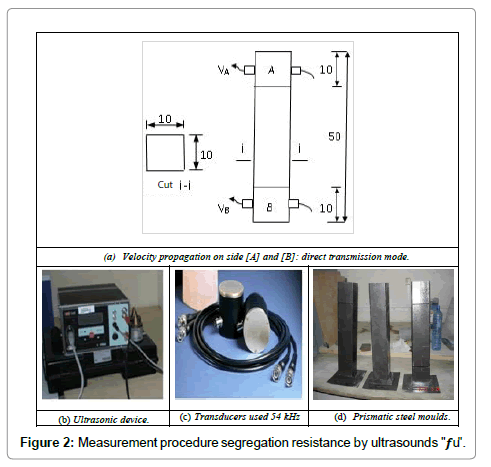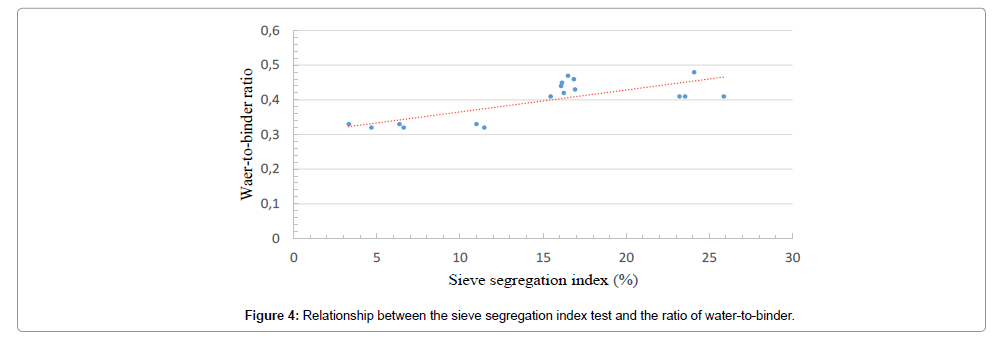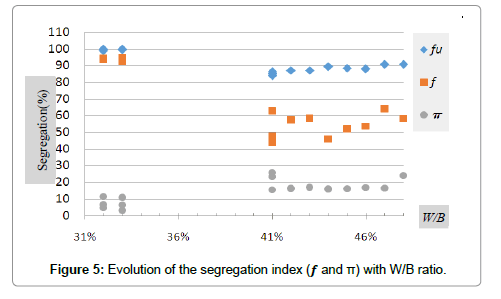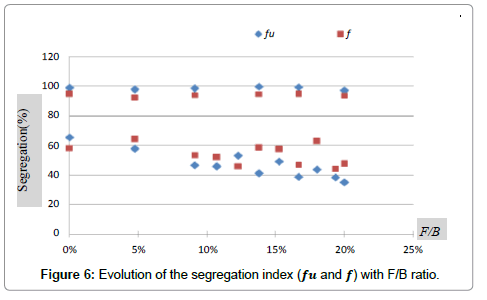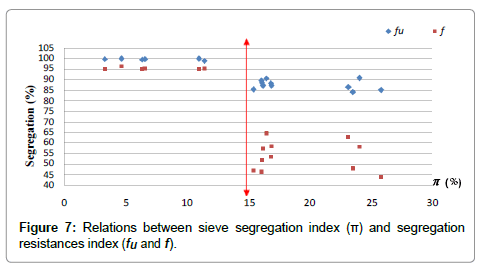Research Article Open Access
Investigation of Concrete Segregation by Ultrasonic Pulse Velocity
Grini Abdelouaheb1,2* and Benouis Abdelhalim11Civil Engineering and Hydraulic Laboratory, University of Guelma, Algeria
2Faculty of Architecture and urbanism, University of Constantine 3, Algeria
- *Corresponding Author:
- Grini Abdelouaheb
Civil Engineering and Hydraulic Laboratory
University of Guelma, Algeria
Tel: +213 776 23 82 41
E-mail: abdelouahab.grini@yahoo.fr
Received Date: May 13, 2016; Accepted Date: August 09, 2016; Published Date: September 18, 2016
Citation: Abdelouaheb G, Abdelhalim B (2016) Investigation of Concrete Segregation by Ultrasonic Pulse Velocity. J Archit Eng Tech 5: 169. doi: 10.4172/2168-9717.1000169
Copyright: © 2016 Abdelouaheb G, et al. This is an open-access article distributed under the terms of the Creative Commons Attribution License, which permits unrestricted use, distribution, and reproduction in any medium, provided the original author and source are credited.
Visit for more related articles at Journal of Architectural Engineering Technology
Abstract
Segregation is the separation of the components of fresh concrete or mortar, which can be caused by bad proportioning, insufficient mixing or excessive vibration. There are several tests which can be measured on hardened concrete or at the beginning of hardening. These are generally based on the percentage of the Fine aggregates between the top and the bottom of the samples. Concrete segregation has been tested trough three usual techniques, sieve, column and ultrasonic pulse velocity. Correlations were performed between various segregation indexes (sieve segregation index, column resistance index and ultrasonic resistance index) to test whether the ultrasonic method is efficient compared to the traditional methods. The fresh concrete segregation was firstly assessed on 17 different samples by the sieve segregation index test. The same 17 fresh samples were pre-hardened for an hour in vertical channel (dimension of 100 x 100 x 500 mm), and sub-samples from bottom and top were tested by counting Fine aggregates. Ultrasonic velocities were previously measured on the same samples and possible differences between the top and the bottom were assessed. Six concrete mixtures from the entire samples presented sieve segregation index lower than 15% and segregation resistance by counting course aggregates higher than 95%. These six stable samples have an ultrasonic segregation index approaching 100%. The remaining samples are found to be unstable concretes: sieve segregation index higher than 15%; resistance index "f" lower than 65% and an ultrasonic index of segregation "u" lower than 80%. The ultrasonic pulse velocity method could be a quick and easily alternative in testing segregation of both fresh and hardened concrete.
Keywords
Concrete; Segregation; Stability; Ultrasonic pulse velocity
Introduction
Segregation is a separation of the constituents of a concrete mix or a fresh mortar, which can be caused by insufficient mixing, excessive vibration or major fluidity. In addition, water content is one of the fu ndamental parameters in the composition of concrete. Water quantity and quantity can influence the separation between mortar and gravels [1]. Water-reducing admixtures are used to reduce the quantity of mixing water required to produce concrete of a certain slump. These admixtures (plasticizers, fluidizers, among others) are added to concrete to make high-slump flowing but are not free of excessive bleeding or segregation [2]. On the other hand, in the case of highly cohesive concrete mixtures [3,4] such as those containing limestone filler, even in the absence of external bleed water, static segregation can still take place [5,6] and [7].The mixing method proposed by [8] for SCC is based on equivalent mortars. The literature describes many tests to characterize the segregation, including the sieve segregation index test, cylinder test, column test, ball test, pale test, etc. Shindoh and Matsuoka have evaluated self-compacting concrete test methods [9].
It is known tests performed on samples of hardened concrete or at the beginning of hardening. These tests are generally based on the technique of counting the fine aggregates or non-destructive testing. Some studies discuss non-destructive testing [10,11] to estimate segregation in concrete. Breul et al. use image analysis [12] to estimate on-site concrete segregation. Schwendenmann et al., Li et al. and tribikram discuss segregation in self-compacting concrete walls using gamma densitometry [13,14]. Geoendoscopy and video compaction are used by Idanez et al. to evaluate concrete segregation [15]. Given the multitude of tests used to characterize, are there any relationships between all these methods, particularly in the case of self-compacting concretes (SCC)? The use of a non-destructive method [10,16] could be a replacement solution. The ultrasonic pulse velocity method is the most widely used test for the inspection and evaluation of concrete structures. It is success fu l in situ as well as in the laboratory. This method can also be used to evaluate the homogeneity and the quality of concrete as well as to analyse its deterioration. This method is mainly used for the determination of the dynamic modulus of elasticity and Poisson’s ratio. Many researchers have published results on these two properties, including Naik and Malhotra (1991), and indicated that the relationship between strength and pulse velocity was not linear and that several parameters intervene in this relationship, such as the composition of concrete and its moisture content [17,18]. The standards of RILEM (Europe), ASTM (the United States) and the British Standards Institution propose procedures to establish these correlations [19-21]. Heterogeneity in concrete creates dispersions of the pulsations [22]. These dispersions are caused by indirect factors such as the origin of the concrete mixture and the problems of consolidation (vibration) during the casting of concrete on site. It is possible to make qualitative concrete comparisons in situ. The objective of this experimental study is to analyse correlations between the various indices of segregation and to try to correlate them with the ultrasonic pulse velocity. This work aims to propose a non-destructive and quick method of characterizing the segregation of fresh concretes.
Experimental Tests
Figure 1 show the process followed in the concrete segregation characterization procedure. It is summarized in steps 1, 2 and 3 on the basis of a typical non-destructive characterization method (NDM). It is then estimated that the segregation index f according to both the non-destructive methods and the ultrasonic procedure. The ultrasonic test method and the column test method measure both the segregation and also plastic sedimentation. Plastic sedimentation is affected by segregation, bleeding and by time setting (Figure 1).
Materials: The materials used were from Algeria, and an ordinary Portland cement (CEM II-A, 42.50) is used in all compositions. In this study, Limestone Filler (a 0/80 μm LF) is used in order to modify the viscosity. The super plasticizer (Médaplast SP40) is a polycarboxylate type based admixture, from the Granitex Company. Local crushed sand with a maximum grain size of 5 mm and gravel with a maximum size of 15 mm are used. The physical properties and chemical composition of Portland cement and mineral admixtures are given in Table 1.
| (%) | CEM | LF | SP |
|---|---|---|---|
| CaCO3(%) | - | 98 | - |
| CaO(%) | 55-65 | 56,03 | - |
| SiO2(%) | 22-28 | 0,04 | - |
| AL2O3(%) | 5-6 | 0,08 | - |
| Fe2O3(%) | 3-3,6 | 0,02 | - |
| MgO(%) | 1-2 | 0,17 | - |
| K2O(%) | 0,3-0,6 | 0,02 | - |
| NaO2(%) | 0,1--0,16 | 0,05 | - |
| SO3(%) | 1,8-2,5 | 0,0021 | - |
| CaOL(%) | 0,8-1,8 | / | - |
| Cl- | 0-0,01 | 0,0033 | <1 |
| Loss on ignition(%) | - | 43 | - |
| Density | 3,15 | 2,7 | 1,2 |
| Blaine(cm2/g) | 3300-4000 | - | |
| pH | - | 9 | 8,2 |
| Beginning of setting time(s) | ≥60 | - | - |
| End o fsetting time(s) | 150-250 | - | - |
Table 1: Physical and chemical proprieties of the used materials.
Mixture proportions: In this work aim to assess the segregation resistance and evaluate the applicability of ultrasonic velocity measurements of the various SCC mixtures made. The formulation has been realized according to the Japanese method requirements suggested by Okamura and Masahiro [8] and the approach followed by [23-25]. The proportion of fine aggregate has been fixed to 50% of each mixture’s capacity and that of sand to 40% of the total volume of mortar. The volume of the SCC paste should allow the concrete to flow while reducing the cost of the raw material in this formulation. The compositions of mixtures are presented in Table 2.
| Proportions in kg/m3 | |||||||||
|---|---|---|---|---|---|---|---|---|---|
| Concrete | Gravel | Sand | Cement | Fillers | Water | Super- | a*=F/B*(%) | b*=SP/B(%) | d*=W/B(%) |
| (5-15mm) | (0-5mm) | (F) | (W) | ||||||
| C01 | 495 | 0 | 237,8 | 9,91 | 0,00 | 2,00 | 48 | ||
| C02 | 477 | 24 | 235,2 | 9,71 | 4,76 | 1,94 | 47 | ||
| C03 | 460 | 46 | 232,5 | 9,50 | 9.09 | 1,88 | 46 | ||
| C04 | 457 | 55 | 230,2 | 9,49 | 10,71 | 1,86 | 45 | ||
| C05 | 454 | 64 | 227,8 | 9,48 | 12,28 | 1.83 | 44 | ||
| C06 | 452 | 72 | 225,3 | 9,47 | 13,79 | 1,81 | 43 | ||
| C07 | 450 | 81 | 222,8 | 9,46 | 15,25 | 1,78 | 42 | ||
| C08 | 448 | 90 | 220,2 | 9,45 | 16,67 | 1,76 | 41 | ||
| C09 | 440 | 97 | 220,1 | 9,32 | 18,03 | 1,74 | 41 | ||
| C10 | 433 | 104 | 219,9 | 9,18 | 19,35 | 1,71 | 41 | ||
| C11 | 775 | 736 | 429 | 107 | 219,8 | 9,11 | 20,00 | 1,70 | 41 |
| C12 | 618 | 0 | 198,0 | 12,35 | 0,00 | 2,00 | 32 | ||
| C13 | 577 | 29 | 200,0 | 11,76 | 4,76 | 1,94 | 33 | ||
| C14 | 550 | 55 | 200,0 | 11,37 | 9,09 | 1,88 | 33 | ||
| C15 | 528 | 84 | 196,0 | 11,06 | 13,79 | 1,81 | 32 | ||
| C16 | 509 | 102 | 195,0 | 10,75 | 16,67 | 1,76 | 32 | ||
| C17 | 488 | 122 | 195,0 | 10,36 | 20,00 | 1,70 | 33 | ||
Table 2: Mixture proportions.
Test procedure: In order to make the samples, the test column used to evaluate the segregation resistance is a steel mould measuring 500 mm in height and 100 × 100 mm in cross-section, where two transducers are applied at two heights. To study the segregation, 17 mixes realized. In all the mixes, kept the quantity of binder constant and varied the ratio of the different constituents compared to the binder; the percentage of the filler was varied from 0 to 20%, that of the super plasticizer from 1,7 to 2% and that of water from 32 to 48%. Table 2 shows the different mixes used.
Plasticizer (Sp)
*B; binder, (a=F/B); limestone filler-to-binder ratio, (b=Sp/B); super plasticizer to binder ratio, (d=W/B); water-to-binder ratio.
The experimental work carried out on these different mixes was at first about the characterization of the self-compaction propriety of the mixes and then the characterization of segregation itself by means of;
1. The sieving method (π=p1/p). (1)
2. The column method (f=A/B). (2)
3. The ultrasonic velocities method proposed (fu=VA/VB) (3)
Characterization of the self-compacting concretes: The characterization of fresh ordinary concrete is limited to workability using the Abram’s cone, and that of self-compacting concrete (SCC) to that recommended by the French Association of Civil Engineering [24], that is, the flow table tests, the “L” box flow and sieve segregation index test. The use of a SCC requires validation through all these three tests (whereas for “ordinary” concrete only one is required). A spread ranging between 64 cm and 72 cm, a H2/H1 ratio higher than 0.80 for the “L” box, and a sieve segregation index π ranging between 0 and 15% are necessary and tests should be carried out in situ as well as in the laboratory.
Characterization of segregation: Several techniques are reported in the literature and they are based on the same principles of the methods as those mentioned by [10,26,27]. The fresh concrete is put in prismatic form (cross-section=150 × 100 mm or 100 × 100 mm, height=400 mm or 500 mm).The concrete was taken from the top and bottom parts of the column. After washing out through a sieve, samples were analyzed to determine the proportion of the fine aggregate. The minimum aggregate size analyzed is > 5 mm. Segregation resistance f is expressed as the ratio between the fine aggregate mass in the top part and the Fine aggregate mass in the bottom part.
f=(M top/M bottom) (4)
According to [2,23,26], inspired by [21].
f > 0.95 corresponds to a good segregation resistance
f< 0.90 corresponds to a tendency to segregation.
Following same principle, During the course of work a steel mould (measuring 500 mm in height and 100 × 100 mm) used and 17 samples for our work in order to determine a similar coefficient but based on ultrasonic pulse velocity ( ).
Ultrasonic velocity measurements: The ultrasonic pulse velocity method can be very use fu l for the study of concrete segregation. Concrete heterogeneity creates dispersions of pulses [11,14]. These dispersions are caused by indirect factors such as the origin of the aggregates, the mixture's ingredients and problems of consolidation (vibration) during the placement of concrete. Thus, based on the previous techniques of segregation characterization, ultrasonic pulse velocities (at the fresh state or at the beginning of hardening) can be used [28-30], to establish correlations between these velocities, sieve segregation Index π and segregation resistance f. The ultrasonic coefficient of segregation resistance proposed will thus be where:
fu=V/V (5)
VA=VfA - VeA: Propagation velocity ratio in the top section [A] between the filled sample and the empty sample.
VB=VfB - VeB: Propagation velocity ratio in the bottom section [B] between the filled sample and the empty sample, respectively (Figure 2a and 2b).
VB=VfB - VeB: Propagation velocity ratio in the bottom section [B] between the filled sample and the empty sample, respectively (Figure 2a and 2b).
Vf: Propagation velocity in a zone, filled sample.
Ve: Propagation velocity in a zone, empty sample.
Concrete density variation through the height of an element can be determined by ultrasonic velocity. Mortar and aggregates do not transmit sound with the same velocity. These differences can therefore be used to evaluate the quantity of aggregates through the height of the elements.
The measurement principle consists in determining the propagation time of sound waves through the fresh concrete at the upper (on side A) and lower parts (on side B) of the samples (Figure 2a).For this, a pair of transducers, one serving as a source (emitter) and the other as a receiver used. According to European Standard EN 12504-4, direct transmission mode one hour after casting used [19-21] (Figure 2a). The system is delivered with a sensor and a nominal frequency transmitter of 54 kHz (Figure 2b), both the industry standard. This nominal frequency limits the depth of propagation and the minimum thickness of concrete that can be probed (Figure 3).
Results of the segregation ultrasonic index are expressed by the ultrasonic velocity ratio of the upper part A to that of the lower part B. These tests were carried out on three samples of each concrete mix. The temperature during mixing and testing was between 18°C and 22°C. The results of the ultrasonic pulse velocity can be used to assess the segregation resistance and to control the quality of concrete products. All the results are summarized in Tables 3, 4 and Figure 4.
| Mixture | C01 | C02 | C03 | C04 | C05 | C06 | C07 | C08 | C09 | C10 | C11 | C12 | C13 | C14 | C15 | C16 | C17 |
| Side-A- | 2198 | 2229 | 2183 | 2232 | 2239 | 2165 | 2166 | 2168 | 2171 | 2161 | 2132 | 2560 | 2567 | 2591 | 2560 | 2559 | 2533 |
| Side-B- | 2421 | 2515 | 2533 | 2520 | 2493 | 2514 | 2444 | 2539 | 2512 | 2540 | 2536 | 2565 | 2580 | 2597 | 2561 | 2561 | 2557 |
| σ* | 157,7 | 202,7 | 247,3 | 203,6 | 180,1 | 246,8 | 196,3 | 261,9 | 241,4 | 267,8 | 285,7 | 4,0 | 9,0 | 4,0 | 0,9 | 1,9 | 17,2 |
*σ, Staar viate.
Table 3a: Sonic auscultation (m/s), one hour after casting.
| Mixture | C01 | C02 | C03 | C04 | C05 | C06 | C07 | C08 | C09 | C10 | C11 | C12 | C13 | C14 | C15 | C16 | C17 |
| Inthetoppart-A- | 0,46 | 0,51 | 0,43 | 0,40 | 0,44 | 0,55 | 0,49 | 0,41 | 0,52 | 0,45 | 0,40 | 0,71 | 0,79 | 0,75 | 0,85 | 0,71 | 0,71 |
| Inthebottompart-B- | 0,78 | 0,80 | 0,80 | 0,75 | 0,95 | 0,96 | 0,86 | 0,87 | 0,83 | 0,85 | 0,84 | 0,74 | 0,83 | 0,79 | 0,89 | 0,73 | 0,74 |
| σ* | 0,23 | 0,21 | 0,26 | 0,25 | 0,36 | 0,29 | 0,26 | 0,33 | 0,22 | 0,28 | 0,31 | 0,02 | 0,03 | 0,03 | 0,03 | 0,02 | 0,02 |
*σ, Staar viate.
Table 3b: Fine aggregate mass (kg), one hour after casting (g).
Results and Discussion
By analyzing the results presented in Figure 4, it can be seen that the risk of instability becomes important when the W/B ratio exceeds 0.33 but that the instability risk decreases when the W/B ratio increases.
Table 3 shows that the ultrasonic velocity remains almost constant in the case of C12, C13, C14, C15, C16 and C17. The variation between their values does not exceed 24 m/s. For these concretes, the standard deviation σ does not exceed 17 m/s. For other concretes, the variation of velocity values exceeds, in some cases, 223 m/s. In some cases, the standard deviation σ exceeds 158 m/s.
Table 4 also shows that the coefficients of segregation resistance remain almost constant in the case of C12, C13, C14, C15, C16 and C17. The variation between their values does not exceed 0.9%, 8.15% and 1.30% for the ultrasonic pulse velocity test method, column test method and sieve test method, respectively.
On the basis of the stability test results, it can be concluded that the concretes C12, C13, C14, C15, C16 and C17 present a very satisfactory stability compared to other concretes.
It is noticed that the first eleven concrete mixes (C01–C11) were not self-compacting, with a sieve segregation index higher than 15%. The last six concretes (C12–C17) are self-compacting and present sieve segregation index lower than 15% and their resistance index stability is higher than 95%. These concretes presented an ultrasonic index of segregation approaching 100% (Table 4).
| Concrete | a=F/B(%) | b=SP/B(%) | d=W/B(%) | fu=V/V | f=l | π*(sieve) |
|---|---|---|---|---|---|---|
| C01 | 0,00 | 2,00 | 0,48 | 90,80±3,5 | 58,30±0,1 | 24,08 |
| C02 | 4,76 | 1,94 | 0,47 | 90,70±0,4 | 64,30±4,3 | 16,49 |
| C03 | 9,09 | 1,88 | 0,46 | 88,20±1,8 | 53,60±5,1 | 16,84 |
| C04 | 10,71 | 1,86 | 0,45 | 88,60±0,8 | 52,00±4, | 16,12 |
| C05 | 12,28 | 1.83 | 0,44 | 89,50±0,0 | 46,10±4.6 | 16,08 |
| C06 | 13,79 | 1,81 | 0,43 | 87,20±1,2 | 58,50±3,8 | 16,91 |
| C07 | 15,25 | 1,78 | 0,42 | 87,20±2,3 | 57,40±1,8 | 16,23 |
| C08 | 16,67 | 1,76 | 0,41 | 85,40±0,9 | 47,10±1,3 | 15,45 |
| C09 | 18,03 | 1,74 | 0,41 | 86,40±2,1 | 62,90±5,0 | 23,20 |
| C10 | 19,35 | 1,71 | 0,41 | 85,10±2,3 | 44,00±4,0 | 25,87 |
| C11 | 20,00 | 1,70 | 0,41 | 84,10±0,3 | 47,70±2,8 | 23,53 |
| C12 | 0,00 | 2,00 | 0,32 | 99,80±0,0 | 95,30±0,7 | 06,60 |
| C13 | 4,76 | 1,94 | 0,33 | 99,50±0,3 | 95,20±0,2 | 06,35 |
| C14 | 9,09 | 1,88 | 0,33 | 99,80±0,2 | 95,10±0,5 | 03,30 |
| C15 | 13,79 | 1,81 | 0,33 | 99,90±0,2 | 95,10±2,2 | 10,98 |
| C16 | 16,67 | 1,76 | 0,32 | 99,90±0,1 | 96,40±1,6 | 04,67 |
| C17 | 20,00 | 1,70 | 0,32 | 99,00±0,6 | 95,30±2,5 | 11,45 |
*(%); percentage of laitance, which represents the ratio between the mass passing a 5-mm sieve and the initial mass of concrete placed on the sieve.
Table 4: Results of all tests.
The effect of the water quantity is illustrated in Figure 5, from which we can see an important influence of this parameter on the segregation of the concretes. The segregation appears, by the three indicators, for W/B ratios higher than 0. 32. A decrease of this ratio by 22% causes a decrease in the indicators of the segregation π of 51% and an increase of f and fu of 100% and 18% respectively For the concretes with 20% of fillers (C11-C17)
*σ, Staar viate.
Table 3b: Fine aggregate mass (kg), one hour after casting (g).
Figure 6 shows the evolution of the two indicators of segregation π (fu and f), with the F/B ratio similar in both cases. The ultrasonic coefficient fu is less sensitive to the variation of the fines quantity in the concrete, especially for unstable concretes, than the coefficient of resistance f. This variation is respectively 8% and 22% for 20% variation of the F/B ratio. This is due to the fact that ultrasonic velocities are determined through the concrete (mortar and gravel), whereas for the resistance segregation index f, it relates only to gravel (Figure 7).
The stable concretes (C12, C13, C14, C15, C16 and C17) are those having a sieve segregation index lower than 15%, and it is proved that all these concretes presented an ultrasonic index fu higher than 98% (Figure 7). It can be seen that when the difference of aggregates content in the column f does not vary by more than 5%, the segregation ultrasonic index fu does not vary more than 2% for stable concretes. For fresh concrete, the ultrasonic pulse velocity method can thus be used for segregation characterization.
Conclusion
In this experimental study, a non-destructive method was tested to diagnose the homogeneity of the concrete in terms of segregation. It is proved through the tested concrete mixes that the proportion of water is a determinant parameter in the manifestation of the segregation.
A decrease in the W/B ratio leads to very different increases of the segregation indices fu, f and π but with the same tendency. The segregation ultrasonic index fu is less sensitive to the variation of the fines ratio, especially for unstable concretes, than the segregation resistance index f. The effect of F/B has the same result.
This is due to the fact that the ultrasonic velocities are determined through the cement paste and granular skeleton, whereas the f index concerns gravels only. The stable concretes are those having a sieve segregation index lower than 15%, and it is proved that all these concretes presented a resistance index f higher than 95% and an ultrasonic index fu higher than 98%. In this study it was also found that the concretes C12, C13, C14, C15, C16 and C17 are very stable compared with the others. Regardless of the measuring methods, and the water proportions used, the ultrasonic velocities of these concretes remain almost constant. The results found by ultrasonic velocity and those found by empirical testing are similar.
Through this study, it is shown that is possible to characterize concrete segregation by a non-destructive method speedily and easily with an acceptable precision. The results show the effectiveness of the proposed approach.
Future work should focus on a more precise analysis of the weight, the nature of the gravel (the effect of geometry on the gravel segregation), the shape of the test piece (edge effect), as well as the frequency of the ultrasonic transducers.
References
- Li L, Kwan G, Kh A (2013) Concrete mix design based on water film thickness and paste film thickness. Cement and Concrete Composite 39: 33-42.
- Uysal M, Yilmaz K, Ipek AM (2012) The effect of mineral admixtures on mechanical proper- ties, chloride ion permeability and impermeability of self-compacting concrete. Construction and Building Materials 27: 263-270.
- Ghafoori N, Diawara H (2010) Evaluation of fresh properties of self-consolidating concrete under long transportation time and extreme temperature. Proceeding of SCC 2010, Design, Production and Placement of Self-consolidation concrete (Ed by Khayat KH and Feys D), Canada pp: 139-152.
- Job T, Harilal B (2014) Fresh and hardened properties of concrete containing cold bonded aggregates. Advances in Concrete Construction 2: 77-89.
- Khayat HK, Guizani Z (1997) Use of viscosity-modifying admixtures en enhance stability of fluid concrete. ACI Mater J 94: 332-340.
- Sunil BD, Chore HS (2014) Rheological properties of self-consolidating concrete with various mineral admixtures. Structural Engineering and Mechanics, An Int'l Journal 51: 1-13.
- Vakhshouri B, Nejadi S (2016) Self-compacting light-weight concrete; mix design and proportions. Structural Engineering and Mechanics, An Int'l Journal 58: 143-161.
- Okamura H., Ouchi, M. (2003) Self-compacting concrete. Advanced Concrete Technology 6: 3-15.
- Shindoh T, Matsuoka Y (2003) Development of combination-type self-compating, concrete and evaluation test methods. Advanced Concrete Technology 1: 26-36.
- Kumavat HR, Tapkire G, Patil PS, Chitte CJ (2014) Condition assessment of concrete with ndt. International Journal of Research in Engineering and Technology.
- Mesbah HA, Yahia A, Khayat KH (2011) Electrical conductivity method to assess static stability of self-consolidating concrete. Cement and Concrete Research 41: 451-458.
- Silva P, Brito J (2013) Electrical resistivity and capillarity of self-compacting concrete with incorporation of fly ash and limestone filler. Adv Concrete Constr 1: 65-84.
- Breul P, Geoffray JM, Haddani Y (2008) On Site Concrete Segregation Estimation Using Image Analysis. Advanced Concrete Technology 6: 171-180.
- Schwhdenmann G (2005) Study of segregation in self-compacting concrete walls using gamma densitometry. 2nd North American Conference on the design and use of self-consolidating concrete and the 4th RILEM symposium on self-compacting concrete, Chicago, USA 2.
- Li B, Duan Y, Zhang Y, Liu S (2011) Electromagnetic wave absorption properties of cement based composites filled with porous materials. Mater Design 32: 3017-3020.
- Tribikram K (2014) Ultrasonic and Electromagnetic Waves for Nondestructive Evaluation and Structural Health Monitoring. 1st International Conference on Structural Integrity, Dep. of Civil Engineering and Engineering Mechanics, Dep. of Aerospace and Mechanical Engineering University of Arizona, Tucson, Arizona 85721, USA.
- Idanez DG, Haddani Y (2004) Etude de la ségrégation des bétons basée sur la géo- endoscopie et du vidéo compatage. Rapport de fin d'étude CUST, p: 80.
- Benouis A, Grini A (2011) Estimation of concrete’s porosity by ultrasounds. SD Physics Procedia 21: 53-58.
- Naik TR, Malhotra VM (1991) Chapter 7: the ultrasonic pulse velocity method. VM Malhotra, NJ Carino, CRC Handbook on Nondestructive Testing of Concrete, CRC Press, pp: 169-188.
- Malhotra VM, Carino NJ (1991) Handbook on Non Destructive Testing of Concrete. CRC Press LLC.
- RILEM (1973) Tests on the concrete by the method of the ultrasonic testing: recommendation of RILEM. Annals of the Technical Institute of the Building and Public Works, Series: Test and Measurements 142.
- ASTM (1998) 597 Standard Test Method for Pulse Velocity through Concrete. ASTM C USA.
- British (2004) Testing Concrete. Part 4. Determination of Ultrasonic Pulse Velocity, Standards Institu- tion BS EN 12504-4, London
- Guoxuan X, Min D, Haiqing H and Mingshu T (2011) Absorbing and mechanical properties of cement-based composites with nano titanic oxide absorbent. Adv Mater Res 177: 558-561.
- Cussigh F et al (2003) Project testing SCC-segregation test methods. In Wallevik O Nielsson Self-Compacting Concrete third international RILEM symposium on self-compacting concrete, Reykjavik. RILEM Publications SARL, Bagneux, pp: 311-322.
- AFGC (2000) Les bétons autoplacants. Recommandations provisoires, Association Française de Génie Civil, France.
- Bensebti S (2008) Essai de caractérisation expérimentale de la ségrégation verticale des bétons auto- placants. Thèse de Doctorat, université de Constantine, Algérie 25: 59-64.
- Sonebi M (2004) Medium strength self-compacting concrete containing fly ash modeling using factorial experiment plans. Cement and Concrete Research 34: 1199-1208.
- Rooney MJ (2001) Development of the settlement column segregation test for fresh self- compacting concrete.
- Hamidian M (2012) Application of Schmidt rebound hammer and ultrasonic pulse velocity techniques for structural health monitoring. Scientific Research and Essays 7: 1997-2001.
Relevant Topics
- Architect
- Architectural Drawing
- Architectural Engineering
- Building design
- Building Information Modeling (BIM)
- Concrete
- Construction
- Construction Engineering
- Construction Estimating Software
- Engineering Drawing
- Fabric Formwork
- Interior Design
- Interior Designing
- Landscape Architecture
- Smart Buildings
- Sociology of Architecture
- Structural Analysis
- Sustainable Design
- Urban Design
- Urban Planner
Recommended Journals
Article Tools
Article Usage
- Total views: 14320
- [From(publication date):
September-2016 - Apr 02, 2025] - Breakdown by view type
- HTML page views : 13218
- PDF downloads : 1102

